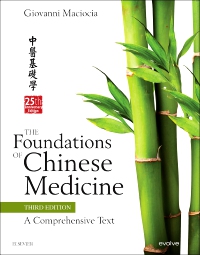
Evolve Resources for The Foundations of Chinese Medicine, 3rd Edition
Resources

$0.00
An accompanying EVOLVE website provides:
- 650 self-testing questions and answers to help readers check their understanding of frequently complex information
- New Case Histories help ‘bring the subject to life’
- Expanded subject area coverage including new clinical guidelines and additional acupuncture point combinations
- Further analysis of acupuncture point actions
- Innovative guidelines aid students learning Chinese Medicine patterns
-
- 25th Anniversary edition of the Western world’s best-selling book on Chinese medicine!
- Logical, sequential organization builds from basic theoretical concepts, through functions of individual organs, diagnosis, pathology, pattern recognition & disease categories, and the appropriate use of acupuncture points
- Clearly explains the theory and practice of Chinese Medicine to Western medical audiences
- Based on a unique and invaluable combination of extensive clinical experience in the West, current Chinese Medicine textbooks and ancient sources, in particular, the ‘Yellow Emperor’s Classic of Internal Medicine’ (Nei Jing) and the ‘Classic of Difficulties’ (Nan Jing)
- Includes Pinyin equivalents to make it immediately evident which original term is being translated
- Abundantly illustrated with over 750 line drawings and more than 1000 tables & boxes designed to emphasize the key facts
- End of chapter Learning Outcomes point out ‘must-know’ information
- Cases Studies and Case Histories apply theory to diagnosis and treatment, bringing the subject to life in a realistic context
- An extensive Glossary explains new terms and their origins from translation
- Additional Appendices list Prescriptions, Bibliography and Chinese Chronology
- Authored by Giovanni Maciocia, one of the Western world's leading subject matter experts
-
- An accompanying EVOLVE website provides over 650 self-testing questions and answers to help readers check their understanding of frequently complex information
- New Case Histories help ‘bring the subject to life’
- Expanded subject area coverage including new clinical guidelines and additional acupuncture point combinations
- Contains further analysis of acupuncture point actions
- Innovative guidelines aid students learning Chinese Medicine patterns
-
1 Yin – Yang
2 The Five Elements
3 The Vital Substances
4 The Transformation of Qi
5 The Functions of the Internal Organs
6 The Functions of the Heart
7 The Functions of the Liver
8 The Functions of the Lungs
9 The Functions of the Spleen
10 The Functions of the Kidneys
11 The Functions of the Pericardium
12 Yin Organ Interrelationships
13 The Functions of the Stomach
14 The Functions of the Small Intestine
15 The Functions of the Large Intestine
16 Functions of the Gall Bladder
17 The Functions of the Bladder
18 The Functions of the Triple Burner
19 The Functions of the Six Extraordinary Yang Organs (The Four Seas)
20 Internal Causes of Disease
21 External Causes of Disease
22 Miscellaneous Causes of Disease
23 Diagnosis by Observation
24 Diagnosis by Interrogation
25 Diagnosis by Palpation
26 Diagnosis by Hearing and Smelling
27 The Pathology of Full and Empty Conditions
28 The Pathology of Yin-Yang Imbalance
29 Pathology of the Qi Mechanism
30 Identification of Patterns According to the Eight Principles
31 Identification of Patterns According to Qi-Blood-Body Fluids
32 Heart Patterns
33 Pericardium Patterns
34 Liver Patterns
35 Lung Patterns
36 Spleen Patterns
37 Kidney Patterns
38 Stomach Patterns
39 Small Intestine Patterns
40 Large Intestine Patterns
41 Gall-Bladder Patterns
42 Bladder Patterns
43 Identification of Patterns According to Pathogenic Factors
44 Identification of Patterns According to the Six Stages
45 Identification of Patterns According to the Four Levels
46 Identification of Patterns According to the Three Burners
47 Identification of Patterns According to the 12 Channels
48 Identification of Patterns to the Eight Extraordinary Vessels
49 Identification of Patterns According to the Five Elements
50 The Five Transporting Points (Shu Points)
51 The Functions of Specific Categories of Points
52 The 8 Extraordinary Vessels: Introduction
53 The 8 Extraordinary Vessels
54 Lung Channel
55 Large Intestine Channel
56 Stomach Channel
57 Spleen Channel
58 Heart Channel
59 Small Intestine Channel
60 Bladder Channel
61 Kidney Channel
62 Pericardium Channel
63 Triple Burner Channel
64 Gall-Bladder Channel
65 Liver Channel
66 Directing Vessel (Ren Mai)
67 Governing Vessel
68 Extra Points
69 Principles of Treatment
70 Principles of Combination Points

 as described in our
as described in our 